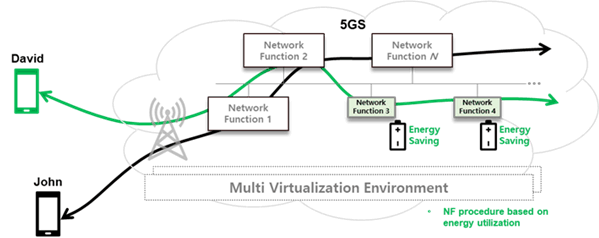Content for TR 22.882 Word version: 19.3.0
5.13 Use case on energy as service criteria for 5G environment adaptation
5.13.1 Description
5.13.2 Pre-conditions
5.13.3 Service flows
5.13.4 Post-conditions
5.13.5 Existing features partly or fully covering the use case functionality
5.13.6 Potential new requirements needed to support the use case
...
...
5.13 Use case on energy as service criteria for 5G environment adaptation p. 28
5.13.1 Description p. 28
It is becoming more important and challenging for operators and cloud/data service providers to reduce carbon emissions while providing for the best-in-class with optimal service plans to end-users. Many operators including cloud/data service providers run their services on top of multiple virtualized infrastructure environments with different hardware/software having various energy consumptions.
Often, operators are unaware of their own individual network functions' power consumption or requirements, and how they behave with 5GS procedures for end-to-end service quality. Thus, operators should be able to measure and control their network functions with energy-based requirements.
In addition, individual network functions should be able to process, register, discover, select, load (re)balance and overload-control based on their current or predicted energy consumption. This would allow operators to fully control and optimize energy consumption internally, and/or based on various service plans for verticals and end-users. For example, using a 'dynamic energy saving plan' in mind, during a non-busy hour, the operator should be able to provide a service with a limited number of features, smaller capacity and/or relaxed SLA.

Figure 5.13-1: Energy as service criteria for 5G environment adaptation
(⇒ copy of original 3GPP image)
(⇒ copy of original 3GPP image)
5.13.2 Pre-conditions p. 29
5G system supports individual network functions monitoring of energy consumption.
It also supports for registration, discovery, selection, load-(re)balance and overload-control of individual network functions based on their energy consumption.
5.13.3 Service flows p. 29
- David and John are subscribed to operator A with different service plans.
- During operator's A 5G service time over the 24 hours, depending on the number of subscribers and various service plans, the individual or groups of network functions are adapted, migrated and/or scaled based on their energy-efficiency requirements and plans.
- Operator A has the ability to set their individual network functions to operate (e.g., for UE registration, NF selection, etc.) based on their current or predicted energy consumption.
- By regularly measuring energy consumption of the individual network functions, operator A has the ability to fully optimize their energy savings whilst also maintaining a high service quality along with the time-of-the day. Based on how their network functions behave with energy-saving characteristics and controls, they can provide means to coordinate the operation of individual network functions to target global optimization of energy consumption within the 5G network.
5.13.4 Post-conditions p. 29
David is satisfied and enjoys his lower pricing plan with the awareness of carbon emission.
Operator A is also satisfied because it has the ability to manage (e.g., load balance) its network functions and adapt their procedures based on energy-saving characteristics.
5.13.5 Existing features partly or fully covering the use case functionality p. 29
None.
5.13.6 Potential new requirements needed to support the use case p. 29
[PR.5.13.6.1]
Subject to operator policy and regulatory requirements, the 5G system shall be able to provide a mechanism for one or more network functions to operate based on energy consumption to meet various end-user's service requirements.
[PR.5.13.6.2]
Subject to operator policy and regulatory requirements, the 5G system shall be able to provide means to coordinate the operation of individual network functions to target optimization of energy consumption within the 5G network.